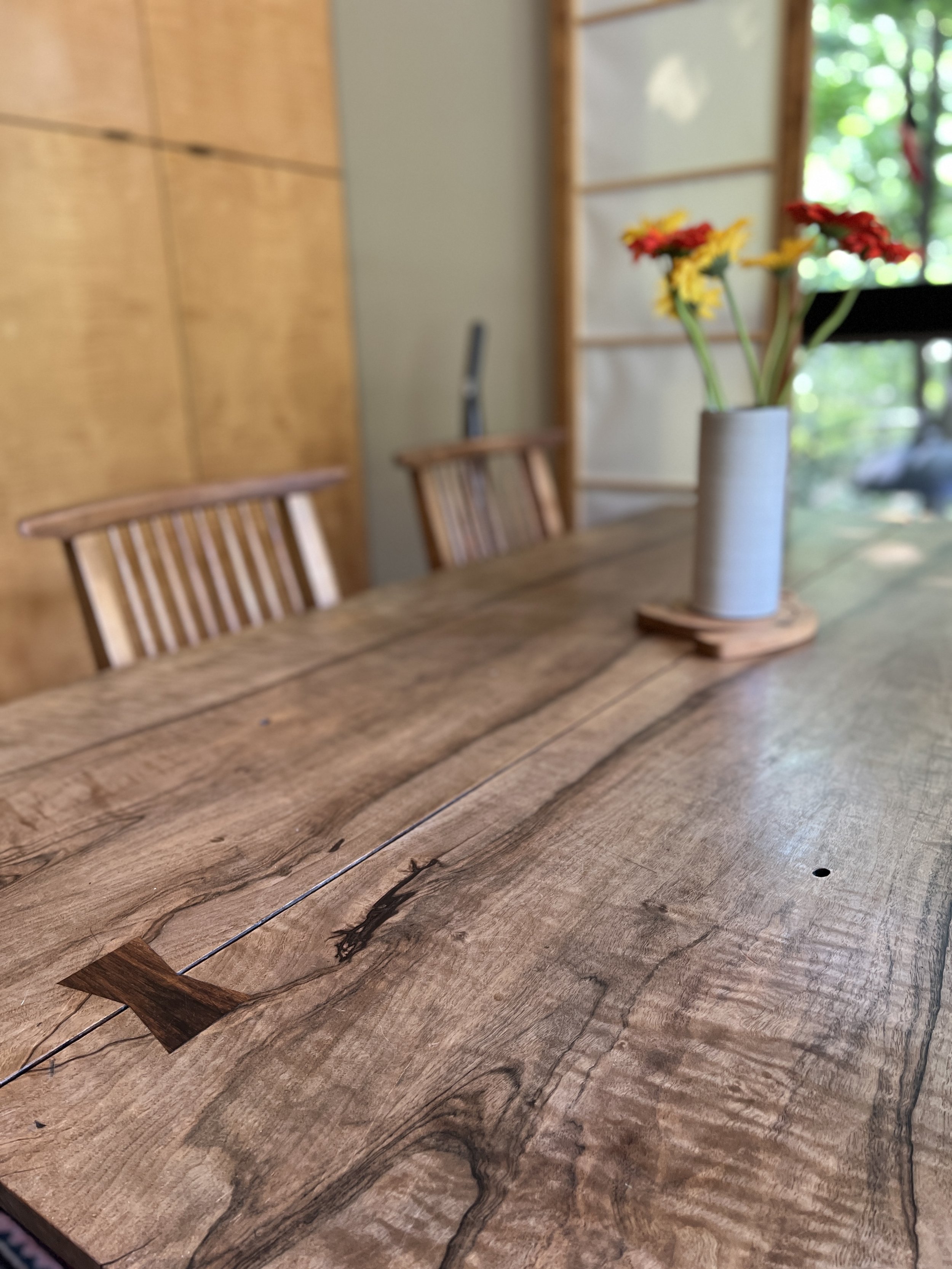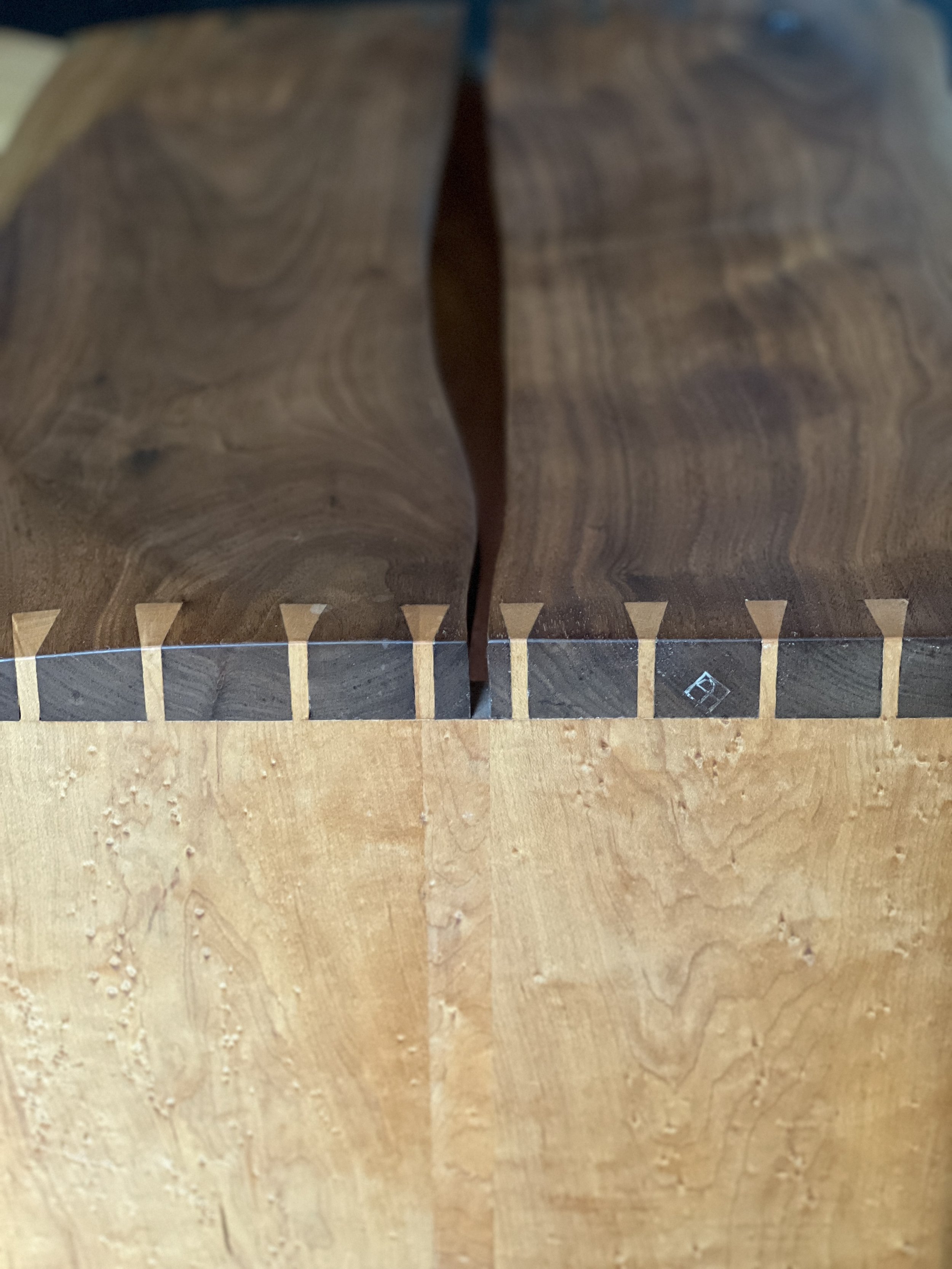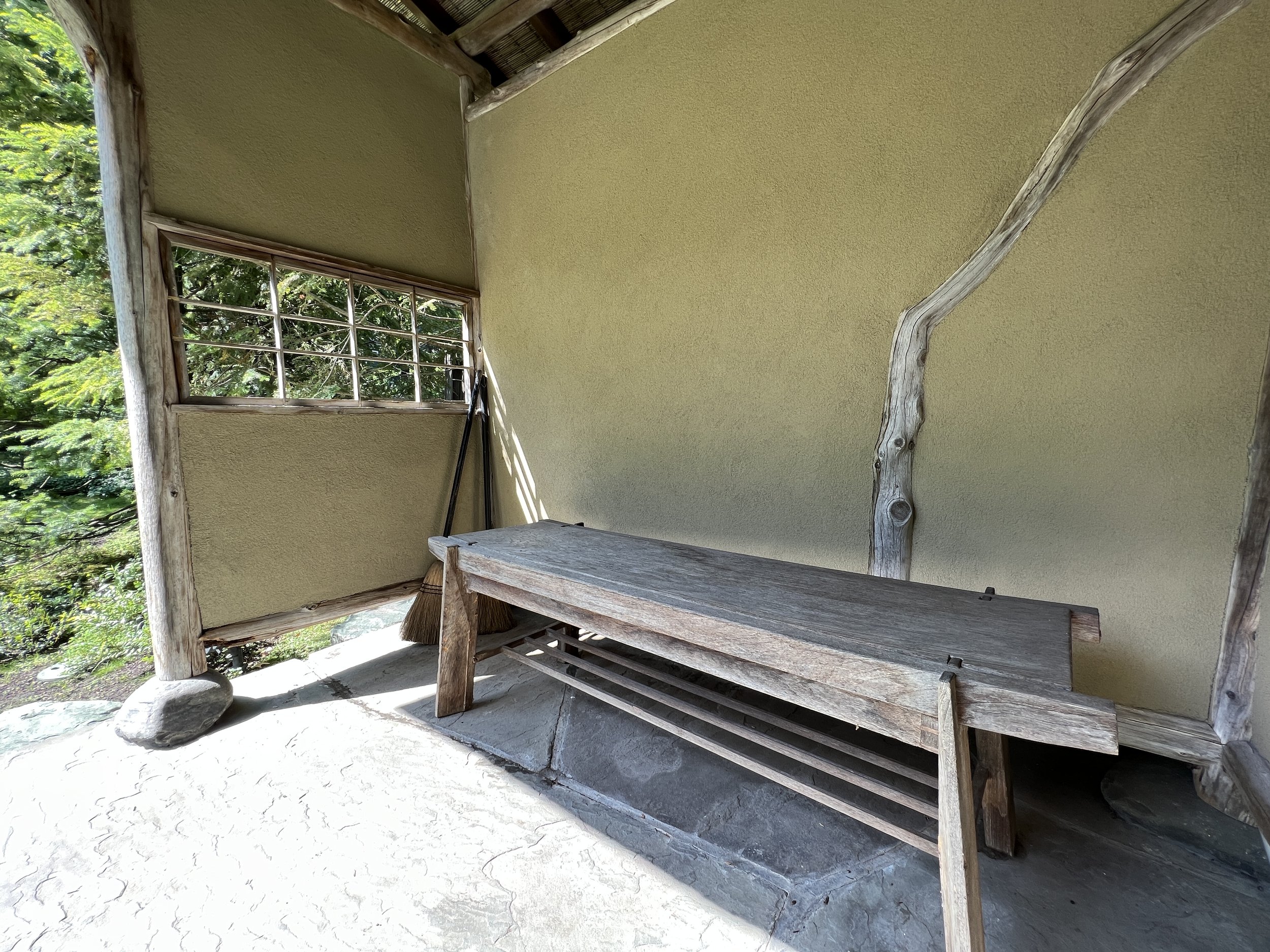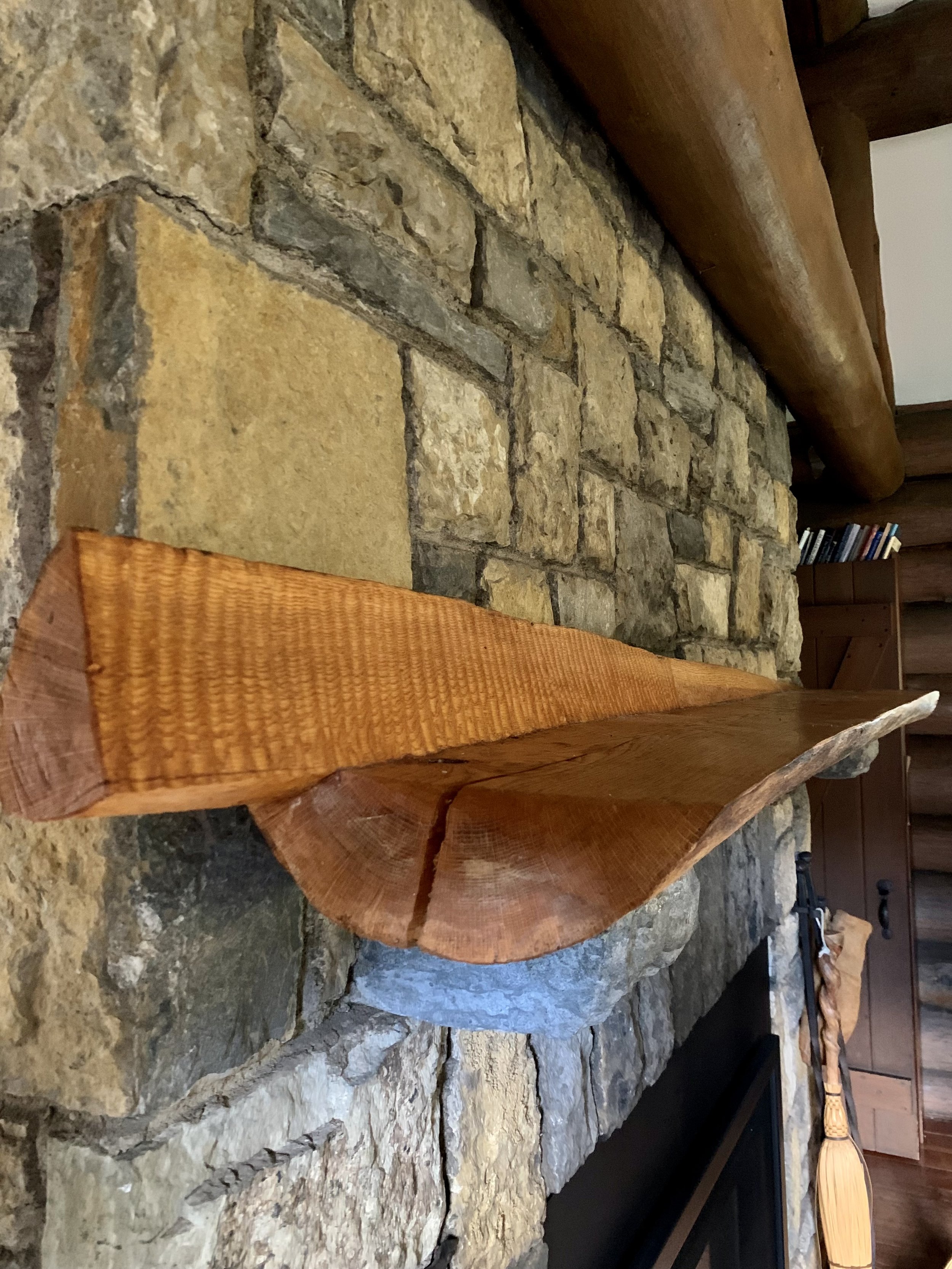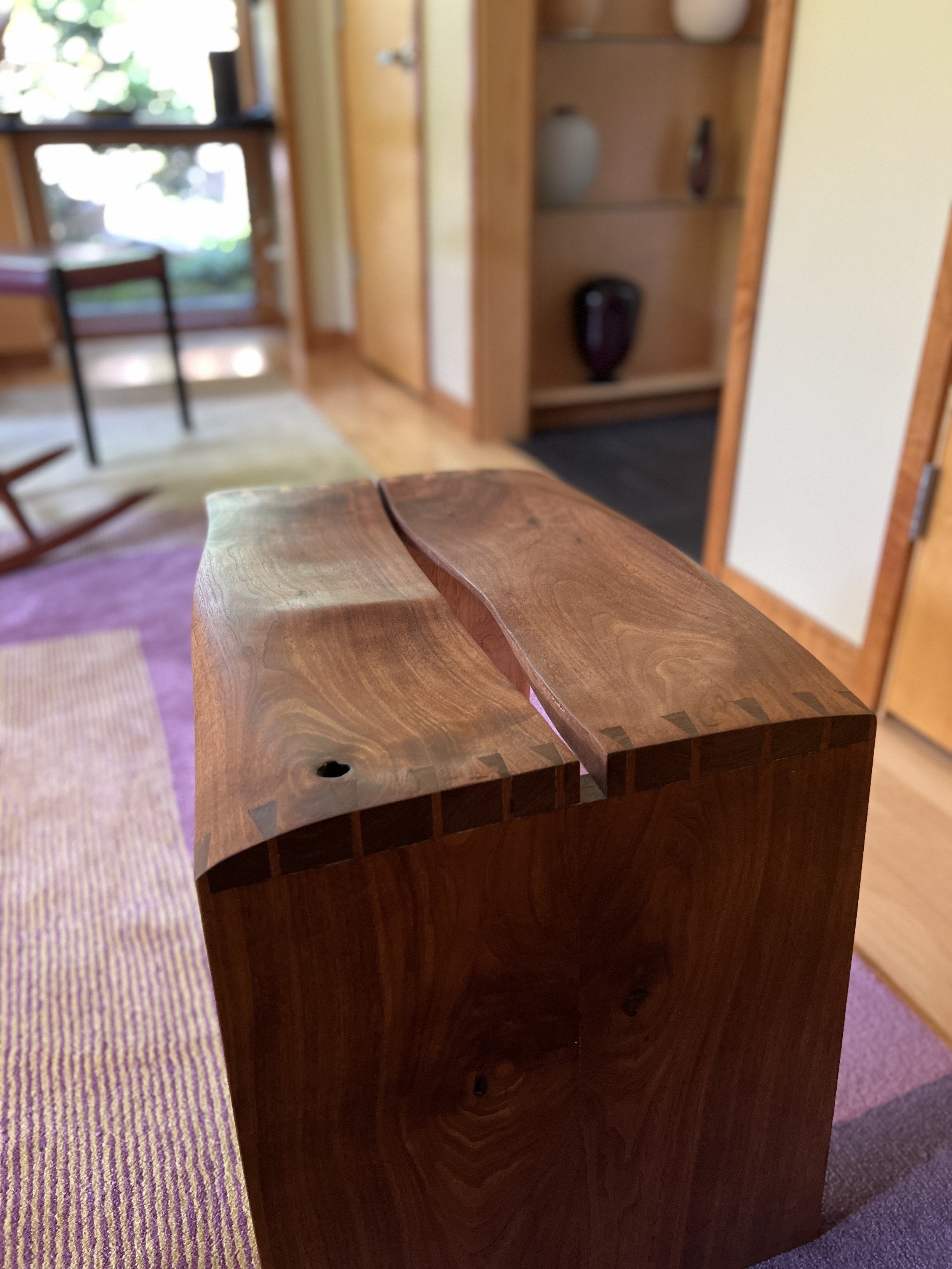
Furniture
George Nakashima
(Woodenworks Catalog, 1972)
Commissioning Furniture
by Linda L Hoeschler, August 2022
Our courage to commission furniture, a habit that continued throughout our marriage, began with my rather impulsive purchase of a table by George Nakashima. I had been engaged by the St. Paul Arts and Science Council to do a high-design 1971-72 annual report-cum-desk calendar (the Council was an umbrella fund-raising organization for many cultural institutions, including the Science Museum of Minnesota, Chimera Theater, St. Paul Chamber Orchestra, Schubert Club, and the Minnesota Museum of Art (MMA)).
In January 1971, after 6 months of hard work, the Council paid me the royal sum of $1200. At the same time, George Reid, the MMA deputy director asked me, under a promise of discretion, if I were interested in purchasing any pieces of furniture from the Woodenworks show that had just closed. Evidently, this seminal exhibit of America’s top wood furniture craftsmen (Nakashima, Esherick, Maloof, Carpenter and Castle, which had inaugurated the Smithsonian’s Renwick Gallery in DC) had insufficient budget to ship the works back to their creators.
Jack and I had recently borrowed $5000 from Grandma Hoeschler, a peach of a gal, as a down-payment on a Ralph Rapson house in the Highland Park section of St. Paul, our home today. We had few savings and Jack had yet to make partner at Doherty, Rumble and Butler. We spent our money carefully: I made most of my own clothes and we had two young children. You get the picture…
I was tempted by two beautiful Sam Maloof chairs, but they were $750 each. And we really needed a kitchen table (to replace the square Formica one we had salvaged from Jack’s father’s Holiday Inn). I thought George Nakashima’s Persian Walnut table was perfect, plus at $1200 I could just endorse my Annual Report payment check to the art museum.
With a mix of confidence and nervousness I called Jack at his office and told him I had just purchased a table for our new home. He asked the price, and when I told him he queried “What wall are you planning to hang it on?!” There was no second-guessing by either of us, then or later – a habit which served our marriage well on many occasions.
We moved into our Rapson home at the end of May 1973, brought in the beautiful table, and commissioned George Nakashima to make us 10 chairs for it; there was only one chair in the exhibit, and George insisted we have matched chairs of black walnut since he couldn’t get any more Persian walnut. The chairs took almost a year to arrive (George shyly explained, that his chair maker had bothersome hemorrhoids and was unable to work for a while). But during the wait and correspondence we felt we got to know and appreciate the warmth, kindness and thoughtfulness of George and his spouse/business manager, Marian.
Early fall 1973 Jack made law partner, and with that promotion he got to choose new furniture for his office. Most partners followed the traditional Williamsburg-reproduction model, with a few modernists choosing Knoll to outfit their workspaces. Jack thought it would be great to visit the Nakashima studio and home in New Hope, Pennsylvania, and ask George to make his law office furniture while staying within the firm’s budget.
In either late 1974 or early 1975 (I am unclear why the delay) Jack met with George and selected the French olive ash slab for his new desktop. Jack loved this process because George had warehouses of wood stacked on end and would “turn” the slabs like book pages to find the best piece for the purpose. George would mark the desk’s dimensions with a piece of white chalk, noting where he’d need wooden butterfly hinges to strengthen certain surfaces. Jack’s massive, gorgeous slab was designed to float above two legal-size pedestal files of black walnut. Jack also ordered a black walnut bench, coffee table, rocking chair and side table.
The artworks arrived in August 1976 at Doherty’s office in the First National Bank Building; Marge Virnig, who worked there then (and later became Jack’s assistant), reports that when word got out about Hoeschler’s new furniture, people would find an excuse to walk down the hallway to Jack’s office and peek in! (Fortunately, when Jack left the firm on good terms in 1983, the firm invited Jack to take his non-conformist furniture with him, joking that they didn’t want desks with holes in the top!)
This marvelous suite of furniture now graces our library, Jack’s library, the place where Jack died in June 2022.
Through the signal gift of hosting the American Craft Show in St. Paul each April, Jack and I met a number of wonderful other artists whom we commissioned.
One of the woodworkers with whom we worked was Robert Erickson of Nevada City, California. In 1988 we asked him to make us an elegant Padauk-wood Bowen side chair for our living room (he had sold the Craft Show model). The seat was sculpted to fit one’s bottom, with sprung back spokes that adjusted to the sitter. The small size was perfect for our mid-century modern home and easily movable. Sometimes we had to urge guests to bypass our upholstered furniture to try Erickson’s instead, at which point it usually became a favorite.
In 1990, and in honor of our upcoming 25th wedding anniversary (1991), we asked Bob to design a similarly-inspired settee (sculpted bottom for two, flat space between the seats, sprung back) for our living room. We didn’t want upholstered furniture that would block the floor-to-ceiling window view behind the settee. Bob proposed several loveseats, but we didn’t want two folks sitting so close together. Unless folks were ‘in love,’ we had learned that people are more comfortable sitting arm’s length from each other.
Bob wanted to call it the “Hoeschler Loveseat”, but we instead suggested “St. Paul Settee.” The Hoeschler name is prone to mangling, and we thought simplicity would win the day. It did, and Bob won awards for this lovely settee that we continue to enjoy 31 years later.
As Bob wrote us in 1993: Thank you for commissioning the bench because, in fact, it has turned out to be a “winner.” The design criteria that you stipulated—that it be slightly curved, and that it be longer than usual with a space between—are the components that set it apart design wise. I realize now that your thoughtfulness articulated the needs of other people as well. The bench is selling well.
Jack and I loved the give-and-take with artists: they taught us and, we think, we taught them. In the end, we believed that we always ended up with a better product—from music, to art, to furniture.
Another woodworker partnership we developed was with Peter Wright from Cable, Wisconsin. I don’t remember where we first met him, but he became our friend and go-to woodworker for over 20 years. Peter first designed several benches for us that had removable tops where a rectangular shallow well could hold mittens, hats, playing cards and games (one bench was used as a coffee table).
Every time we needed an occasional piece, a sculpted stool or bench for a particular place, we called upon Peter Wright to help us out. He even made a mailbox for us and a mantle (for our cabin). There was no project too small or too strange for Peter. We were lucky that he lived only a few hours away and occasionally came to the Twin Cities to visit the galleries that carried his gorgeous works.
Closing the circle of our furniture commissions, at least for the moment, was our work with Mira Nakashima, George’s daughter. Mira had visited the Twin Cities in March 2014 on behalf of the American Craft Council (now headquartered in Minneapolis), and gave a delightful talk at our home, a prelude to dinner.
We showed Mira her father’s work that graced our home (kitchen table/chairs and Jack’s suite of office furniture); she remarked that our dining table was the only table George had ever signed on the top, rather than underneath. In May 2014 we went to Philadelphia for a Georgetown crew celebration and trekked to New Hope to see the exquisite Nakashima complex: showroom, wood storage ‘garages’, fabrication areas, and housing (including a charming residence Nakashima built for his artist-friend Ben Shahn when down on his luck). We were again dazzled by Mira’s dynamism and wanted to explore her artistic vision and craftsmanship.
But with a house full of furniture and in our 70’s, what to do? With our love of music and books we decided to commission Mira to make us a bookstand/music stand for the library and in honor of our 50th wedding anniversary. After several designs which we all continued to simplify, Mira sent us photos of various wood pieces in their ‘library’. We selected a marvelous piece of Oregon Maple Burl to be placed atop a black walnut stand/base.
The stand is perfect and lives next to Jack’s commissioned office desk. The two figured surfaces complement and ‘speak’ to each other, beautiful show-off stars anchored to solid, smooth black walnut.
How lucky we’ve been to work with so many talented artists throughout our marriage, particularly when we have received beautiful artworks from each that continue to enhance our spiritual and visual lives.
Robert Erickson, St. Paul Settee (California black walnut)


